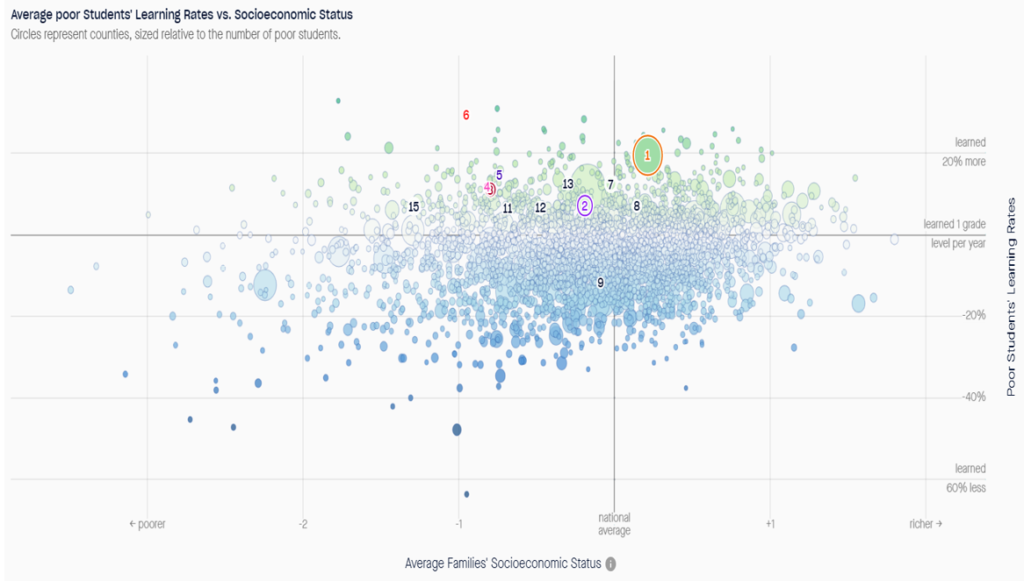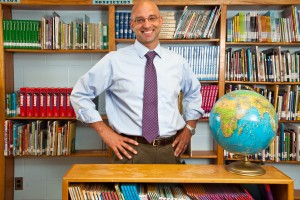
A student at New Orleans Charter Science and Math High School – “Sci High” – shows off the ingredients that earned her a win at the Louisiana Science and Engineering Fair earlier this month.
The Educational Opportunity Project at Stanford University released new data recently, covering the years 2007 to 2018. Opportunity Project scholars linked state achievement exams in grades 3-8 across the country to allow comparisons.
Arizona – the state with the nation’s largest charter school sector, a very active open-enrollment market and private choice programs to boot – demonstrated the highest overall level of academic growth among states, for students overall as well as for low-income students.

The Opportunity Project’s data explorer has a nifty visualization tool that makes charts like the one above. This one shows the rate of academic growth by county for poor children in counties nationwide.
Each dot is a county. The horizontal dividing line is “learned 1 grade level per year.” As you can see, counties teaching poor children less than one grade level per year (blue dots) easily outnumber those teaching more that one grade level per year (green dots).
Arizona counties are numbered. Maricopa County (1) has the highest rate of academic growth for poor children among large urban counties nationwide, 19.3% above one grade level per year. Mighty Maricopa, however, did not rank first in Arizona. That honor goes to Santa Cruz County (6), on the border of Mexico with a rate 29.3% above the dividing line.
Only one Arizona county, Greenlee (9), has a blue rather than a green shade to its dot. Greenlee, a small rural county in eastern Arizona, has no charter or private schools. The reader can decide for him or herself whether this is coincidental.
Arizona has 15 counties, but Navajo County has missing data for low-income students, so it does not appear in the chart; it does, however, have a healthy green dot for all students. County 15 is not technically a county and is not in Arizona. It’s in Orleans Parish, Louisiana, home of the original portfolio school district.
When Hurricane Katrina destroyed New Orleans, authorities found themselves with no students and little to offer but empty school buildings. Louisiana authorities, wisely, offered the use of those buildings to charter school operators in a request for proposal type fashion.
Most, and then all the schools, became charter schools. Students returned and academic results improved. The rate of academic growth for poor children in the Stanford data, averaging 6.8% above learned one grade level per year, shows admirable progress.
It remains an open question whether anyone will ever meaningfully replicate the New Orleans experiment in a sustained fashion. School boards are easy prey to regulatory capture by incumbent interests such as employee unions and major contractors.
The Arizona experience, fortunately, shows that high levels of academic growth for disadvantaged students can be achieved at a statewide scale and without a natural disaster. Arizona has the nation’s largest charter school sector and private choice programs, which in combination seems to have unlocked a very active system of open-enrollment transfers between district schools.
Arizona districts would die on a hill before being forced to convert to charter schools. Fortunately, there doesn’t seem to be much of a need to do so.
 Texas: State lawmakers propose an ambitious school choice expansion plan that includes a tax credit scholarship for low-income students and the lifting of a cap on charter schools (Dallas Morning News). More from the Austin American Statesman and San Antonio Express-News.
Texas: State lawmakers propose an ambitious school choice expansion plan that includes a tax credit scholarship for low-income students and the lifting of a cap on charter schools (Dallas Morning News). More from the Austin American Statesman and San Antonio Express-News.
Tennessee: A key state lawmaker, House Speaker Beth Harwell, says the legislature will consider a statewide charter school authorizer (The Tennessean). Area businesses help push growth of charters in the Nashville area (The Tennessean). Gov. Bill Haslam gives mixed signals on the possibility of voucher legislation next year (Knoxville News-Sentinel). More from the Memphis Commercial Appeal.
Louisiana: The Recovery School District in New Orleans is moving towards an all-charter system (New Orleans Times Picayune). The latest enrollment counts show families who accepted vouchers are sticking with their schools (Alexandria Town Talk).
North Carolina: Charlotte-Mecklenburg schools superintendent Heath Morrison calls private, charter and traditional public school leaders together to discuss the possibility of partnerships (Charlotte Observer).
Indiana: A new study finds the state's charter schools are among the best in the nation when compared to their traditional public school counterparts (Indianapolis Star). But the poor performance of many charters under one authorizer, Ball State University, drags down the overall results (Indianapolis Star).
Illinois: Members of the Chicago teachers union march to protest a wealthy charter school supporter and ally of Mayor Rahm Emanuel (Chicago Sun Times).
Ohio: Federal education officials are investigating whether charter schools in Ohio and three other states - Texas, Pennsylvania and Wisconsin - are discriminating against students with disabilities (StateImpact Ohio).
Wisconsin: Possible expansion of vouchers, extra pay for low-performing schools with improvement plans, and more education funding are all on tap for the next legislative session, Gov. Scott Walker says (Milwaukee Journal Sentinel).
Georgia: A judge rules that the Atlanta school district must stop withholding money from the city's charter schools to help pay for the district's pension program (Atlanta Journal Constitution).
 More than 100 school districts in the U.S. now have 10 percent or more of their students in charter schools, and eight Florida districts are among them, according to a report released Wednesday.
More than 100 school districts in the U.S. now have 10 percent or more of their students in charter schools, and eight Florida districts are among them, according to a report released Wednesday.
The Lee County School District leads Florida districts with 14 percent, says the report from the National Alliance for Public Charter Schools, which is based on enrollment figures for the 2011-12 school year. It’s followed by Broward, Lake, Miami-Dade, Polk and Sarasota (all at 12 percent), Indian River (at 11 percent) and Osceola (at 10 percent).
New Orleans tops all districts with 76 percent, followed by Detroit (41 percent), Washington D.C. (41 percent), Kansas City, Mo. (37 percent) and Flint, Mich. (33 percent).
Two Florida districts are among the 10 fastest-growing for charters. Between 2010-11 and 2011-12, charter enrollment rose from 6,207 to 9,452 in Hillsborough County, a 52 percent increase that put it at No. 2 nationally over that span. Broward County showed a 26 percent increase, putting it at No. 6.
Eight Florida school districts are also among the Top 50 in total number of charter students, but that has a lot to do with how huge Florida districts tend to be. Miami-Dade leads all Florida districts and is No. 6 nationally with 41,767 charter students last year.
For more about the report, see New York Times here and Huffington Post here.
 Students at six high-poverty schools in Memphis returned to class this month as the focus of an education reform project that's worthy of national attention. The schools are the first cluster in the “Achievement School District,” a Race To The Top-fueled vision headed by Chris Barbic, founder of the acclaimed YES Prep charter schools in Houston.
Students at six high-poverty schools in Memphis returned to class this month as the focus of an education reform project that's worthy of national attention. The schools are the first cluster in the “Achievement School District,” a Race To The Top-fueled vision headed by Chris Barbic, founder of the acclaimed YES Prep charter schools in Houston.
The district’s near-term goal – lifting schools in the bottom 5 percent statewide to the top 25 percent within five years – is as ambitious as YES Prep’s target of getting every graduate into a four-year college. Its big-picture goal is even more so: Showing the world that lessons learned from the highest-performing charter schools can turn around the lowest-performing traditional schools.
Barbic calls it Charter School 3.0.
“There’s an opportunity here to say, look, we’re not creating the charter school that’s going to be across the street from the public school and slowly bleed it to death. What we’re saying is, this is the neighborhood school,” Barbic said in the redefinED podcast below (the phone interview was conducted during the first week of school). “To me this is Charter School Version 3.0. – which is, you don’t get to pick the kids; the kids don’t get to pick you. If we really believe this works, we’re going to phase you in and you’re now the neighborhood school. And you got to work with all the kids … whatever kids show up with, you have to serve those kids.”
“If we can pull that off,” Barbic continued, “it’s going to make a huge statement that will hopefully accelerate things like this in your backyard and other places around the country.”
Schools like YES Prep and KIPP share many characteristics – high expectations, high-energy teachers, longer school days, more flexibility at the school and classroom level. And yet, despite a solid body of evidence that they’re making a big difference for low-income kids, they remain fairly rare. Barbic said that’s in part because it’s only been in the past three to five years that they’ve learned to replicate more rapidly. But now, folks inside traditional school systems are beginning to appreciate the benefits.
“You’re seeing things in Denver and things in Houston where there’s efforts being made by the district to try and take the practices of the best charters, the best charter organizations, and try to apply them in a larger system,” he said. “And I think what’s happening in New Orleans with the Recovery School District, what we’re hopefully going to be able to achieve here, is an opportunity to say, ‘Look, this works. And it works at scale, in a neighborhood school environment.’ ”
On a related note, Barbic talks about ASD's parent outreach efforts - which are extraordinary compared to traditional public schools. When teachers showed up for school in early July, buses took them to the communities where their students live. “We hit all the apartment complexes. We banged on doors,” he said. “We met (the parents) and we invited them to come out to a community picnic that we were having later that week.”
The response: “Cautious optimism.”
“They’ve met us halfway,” Barbic said. “Now it’s on us to perform and get some results.”